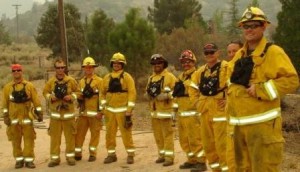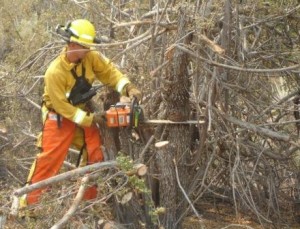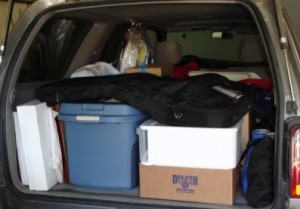During a two-week period when the massive Station Fire marched toward her rural home, Brenda Avadian of TheCaregiversVoice.com began asking questions–lots of them!
On this one-year anniversary of the Station Fire–the largest forest fire in Los Angeles’ history–we revisit lessons learned that also apply to caregiving.
Throughout the years, The Caregiver’s Voice has emphasized the importance of asking questions. Answers help caregivers learn what to expect while caring for loved ones.
Four lessons learned while coping with the Station Fire, can help caregivers navigate along an uncertain and often bumpy terrain.
________________________________________

CARETAKERS protect The American Dream — firefighters take a moment to pose for a very thankful homeowner.
Fire-fighting personnel from different agencies worked 12-hour shifts and visited our community as the fires drew near. Some remained on our property (or nearby) around the clock.
1. Ask questions of each agency and even individual members of an agency, in order to learn what to expect.
Family caregivers interact with multiple agencies while providing care for loved ones–healthcare, respite care, adult day care, board and care, assisted living or nursing care community services, legal, and more.
When the issues are critical, it is important to ask the same questions of each representative. Asking the same questions repeatedly, at least, initially, will provide amore comprehensive and accurate picture of what to expect. Besides, the first time someone explains something, it’s usually hard to grasp, much less remember. Repetition ensures more of the important issues are covered, especially when dealing with multiple agencies; each with their own vision and policies.
2. Listen attentively to their responses, thank them repeatedly for their time, and show eagerness to act upon their suggestions.
Agencies are all to willing to help the thankful caregiver who shows earnestness in following their suggestions.
During their initial property assessment, a team of firefighters advised that we clear more of the brush around our house to better safeguard our property. Early the following morning, my husband and I willingly heeded their advice with help from a neighbor and two friends from a neighboring community.
We worked hard, clearing more brush from behind our home and to the side along our other neighbor’s property. We even climbed on the roof to clear pine needles out of the gutters. Later that morning, the firefighters arrived to see us hard at work. The captain ordered his much younger and stronger crew to help create a “defensible space”–where firefighters feel safe to make a stand against the fire. Although we got a lot of exercise, it was a good thing they came when they did; otherwise, they would have been administering CPR. After a brief break, watching them work, gave us more strength to dig in and help cut tall Fremontia and drag the cuttings fifty yards down to a gathering spot.
3. Allay your fears by learning the worst that can happen. Then ask, “What can I expect if the worst does happen?”
While caring for my father, I wanted to know what the worst was that could happen. There’s a degree of comfort in knowing the worse-case scenario in order to take steps to prepare or, at least, know what to expect.
If the winds shift or increase, we will receive a mandatory evacuation order from the sheriff’s department. We should have our cars packed with everything and backed into the drive in order to leave promptly. We should leave the doors unlocked to our home (the firefighters may need to enter for safety, if the fire comes too fast) and close all windows and doors inside in order to compartmentalize our home. The firefighters will make a stand as long as they feel they can safely. However, when they deem it unsafe, they will sound the horn three times and then leave.
4. Find support among others who are going through the same thing.
We had a “fire support group” to exchange ideas, updates, and to comfort one another, knowing we were all in this together.
We exchanged frequent updates among neighbors and others in the community to assess the fire’s progress. We also visited informative websites.
Sometimes, the agencies didn’t have as recent of information as we did. To tactfully deal with information discrepancy among agencies, I often started with the following:
- This is what I learned (heard).
- What is your assessment?
- What do you think?
I was able to share what I knew in a non-threatening way while encouraging their expert advice–an effective communication strategy; especially, in a crisis setting.
The fire took two intensely involved weeks out of our lives and another, just to get reoriented and balanced (somewhat). During this time we were on high alert, interrupted sleep, exhaustion with the uncertainty (fires with errant winds are unpredictable), while suffering from sinus pain and headaches due to the thick smoke. We finally unpacked the cars, but left everything near the garage door…just in case. Only now, are we slowly bringing things back into the house and placing them where they belong.
As the days of this ordeal wore on, I realized that the firefighters are truly CARETAKERS of The American Dream. When a fire threatens your shelter, your security, your way of life…these crews step in where few others will.
We’re safe now. We still have our home and can live among our things.
The same applies to coping with the uncertainty of caregiving. You’ll survive if you take steps to learn what to expect by asking lots of questions; listen attentively to the answers; consider the worst that may happen; and then find others (for support) who are going through the same experience.
THANK YOU, firefighters. Your presence was helpful and comforting. We even miss you.
Brenda Avadian, MA
TheCaregiversVoice.com
For related articles, click on:
FIRE! Quick! What really matters?
A Caregiver’s Touching Story of Gratitude
For more dramatic photos, visit Wildfires in Southern California at Boston.com [4/4/2023 TCV Update: URL to photos, no longer available.]

















Pingback: A Caregiver’s Touching Story of Gratitude « The Caregiver’s Voice